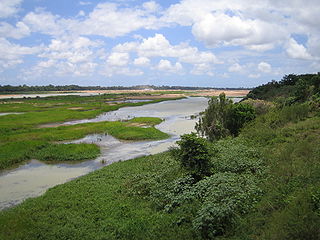
The Burdekin River is a river in North and Far North Queensland, Australia. The river rises on the northern slopes of Boulder Mountain at Valley of Lagoons, part of the western slope of the Seaview Range, and flows into the Coral Sea at Upstart Bay over 200 kilometres (124 mi) to the southeast of the source, with a catchment area of approximately 130,000 square kilometres (50,000 sq mi). The Burdekin River is Australia's largest river by (peak) discharge volume.

Rainbowfishes are small, colourful freshwater fishes belonging to the family Melanotaeniidae, found in northern and eastern Australia, New Guinea, Sulawesi and Madagascar.

The black stilt or kakī (Māori) is a wading bird found in New Zealand. It is one of the world's rarest birds, with 169 adults surviving in the wild as of May 2020. Adult kakī have distinctive black plumage, long pink legs, and a long thin black bill. Black stilts largely breed in the Mackenzie Basin in the South Island, and are threatened by introduced feral cats, ferrets, and hedgehogs as well as habitat degradation from hydroelectric dams, agriculture, and invasive weeds.

The Australian smelt is a small, pelagic silvery freshwater fish found in large numbers in waters of the south eastern Australian mainland.
The Cairns rainbowfish is a species of rainbowfish endemic to Australia. This species is endemic to the wet tropics of north eastern Queensland from the Daintree River and Cape Tribulation in the north south to Innisfail where its occurs in shallow, fast flowing, shady streams over sandy substrates where the roots of trees, woody debris, leaf litter, undercut banks and hydrophytes provide cover.
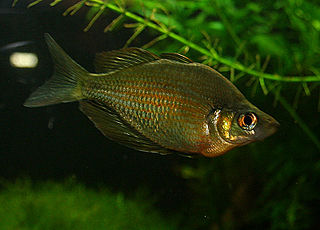
The Lake Wanam rainbowfish is a critically endangered species of rainbowfish in the subfamily Melanotaeniinae. It is endemic to Lake Wanam near Lae in Papua New Guinea. It has virtually disappeared from the small lake due to competition from introduced, non-native tilapias, but captive populations exist.
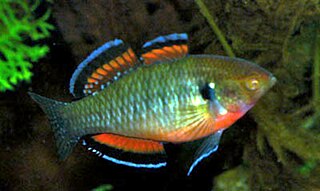
Hypseleotris is a genus of fishes in the family Eleotridae. Most are from fresh water in Australia and New Guinea, but species in fresh and brackish water are found around islands in the western Indian Ocean, southern and eastern Africa, southern and eastern Asia, and Pacific islands. The largest species reaches a length of 12 cm (4.7 in). They are sometimes seen in the aquarium trade; especially H. compressa. In Australia they are known as carp gudgeons.

Melanotaenia is a genus of rainbowfish from Australia, Indonesia, New Guinea, and nearby smaller islands.

The Lake Eacham rainbowfish is a species of rainbowfish in the subfamily Melanotaeniidae which was thought to be endemic to Yidyam, Queensland, Australia but has proven to have a wider range.
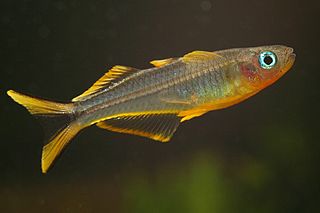
Pseudomugil is a genus of fish in the subfamily Pseudomugilinae endemic to Australia and New Guinea, where they are found in freshwater rivers and streams and bodies of brackish water.
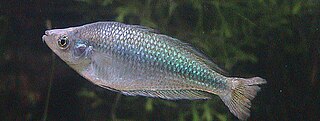
The Murray River rainbowfish, known less commonly as the Australian rainbowfish, is a species of freshwater fish endemic to southeastern Australia. The southernmost species of all rainbowfishes, these fish are very colourful, hence the name; and there is sexual dimorphism with the males being larger and more colourful than females. Murray River rainbowfish are schooling fish and will congregate near logs or riverbanks, and are a popular aquarium fish.

The Mary River flows in the Northern Territory of Australia and is a site of the Mary River National Park.

The ornate rainbowfish is a species of rainbowfish endemic to an area in eastern Australia, where it is native to coastal regions and sandy offshore islands in southern Queensland and northern New South Wales. It is the only known member of its genus. It is a popular aquarium fish.

The black-banded rainbowfish is a species of rainbowfish belonging to the subfamily Melanotaeniidae. The species is endemic to Australia. Importantly, the species is the type species of the genus Melanotaenia.

The Pacific blue-eye is a species of fish in the subfamily Pseudomugilinae native to eastern Australia. Described by Austrian naturalist Rudolf Kner in 1866, it comprises two subspecies that have been regarded as separate species in the past and may be once again with further study. It is a common fish of rivers and estuaries along the eastern seaboard from Cape York in North Queensland to southern New South Wales, the Burdekin Gap in central-north Queensland dividing the ranges of the two subspecies.
The dwarf flathead gudgeon is a species of sleeper goby endemic to eastern Australia.

Melanotaeniinae the Australian rainbowfishes is a subfamily of the rainbowfishes of the family Melanotaeniidae. They are a group of small, colourful, freshwater fish found in northern and eastern Australia, New Guinea, islands in Cenderawasih Bay the Raja Ampat Islands in Indonesia and in Madagascar.
The Daintree rainbowfish is a species of rainbowfish endemic to Australia. This species is endemic to the wet tropics of north eastern Queensland where it has been recorded from the Cooper Creek and nearby Hutchinson Creek systems of the Daintree region of north-eastern Queensland. This species occurs in small clear, shady rainforest streams which flow over a substrate consisting of rock, sand, gravel and log debris. Within these streams the fishes swim near the surface to midwater depths and are frequently found in the deeper pools of these streams where there is a faster current. They will form mixed schools with blue-eyes and other rainbowfishes.

Glossolepis dorityi, the Grime rainbowfish, is a species of rainbowfish native to the Grime River region in northern West Papua.
Oxyeleotris nullipora, the poreless gudgeon, is a gudgeon of the genus Oxyeleotris, a freshwater fish found in Australia and Papua New Guinea.













